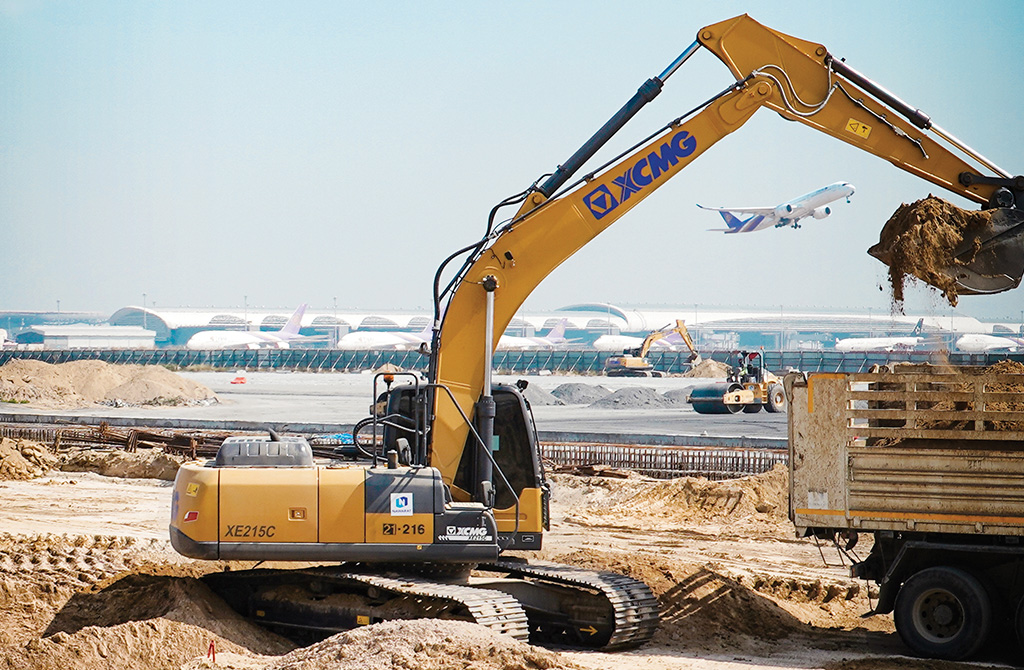Bobcat and XCMG speak with James Morgan about growing levels of demand for mini and mid-sized excavators across African construction markets.
When it comes to global development, few regions boast greater potential than Africa. The continent’s construction market is currently valued at more than $380 billion, according to data from Mordor Intelligence, and is on course to achieve an extremely healthy compound annual growth rate (CAGR) of 7.5% during the period 2023-28.
This, of course, is music to the ears of manufacturers supplying machinery to the region – especially those producing earthmoving equipment, which represents a staple on job sites across the continent. In Africa’s largest economy, Nigeria, the construction industry is expected to grow by 2.8% this year alone, according to research conducted by GlobalData. Meanwhile, analysis from MarketResearch.com shows that excavators accounted for the lion’s share of earthmoving sales in the region’s second-biggest market, South Africa, in 2022.

Yet it could be argued that the most noticeable trend currently taking place within Africa’s earthmoving segment relates to size. Traditionally, larger machines have proved popular in the region thanks, in part, to their capacity, but also because confined worksites were not as common as in markets such as Europe and Asia. But as infrastructure development has accelerated and the population density of urban areas has increased, so too has the requirement for compact and mid-size excavators.
Commenting on the mid-size segment, a spokesperson from China-headquartered XCMG told Plant & Equipment: “At present, we are exporting mid-size excavators primarily to the markets of the Democratic Republic of the Congo, Ghana, Nigeria and Uganda. These machines are used in mines and hydroelectric power stations, as well as for roads, dams and other infrastructure projects.”
Nicolas Dumont, District Sales Manager – Africa at Bobcat, says demand for mini excavators is also on the rise in Africa. “Volumes remain small,” he concedes. “For context, the skid-steer loader (SSL) segment is twice the size of the mini-excavator market, whereas demand for backhoe loaders is 10 times greater. Nevertheless, the requirement for mini excavators is constantly growing; this segment is now approximately 30% larger than it was before the global pandemic.”

Nevertheless, Dumont does not believe this uptick is specifically related to space constraints in African markets. Rather, he contends that it is being driven by a shift away from manual labour. “It’s down to a change in mindset,” he explains. “Decision-makers now understand that, even though completing tasks by hand remains cheap in comparison to the cost of a mini excavator, the productivity achieved by machinery is incomparable.”
In addition to primary markets for mid-sized excavators, XCMG says its earthmovers have enjoyed significant success across a broad range of African nations.
“In Tanzania, dozens of XCMG XE370D excavators were deployed to work day and night at the Rufiji Hydroelectric Power Station project site,” says the company. “Following completion, this facility’s installed capacity reached 2,115MW, which had a significant effect in combating the nation’s energy shortage while facilitating economic development and industrialisation. In the south of the country, XCMG supplied a forest protection and renovation project with several XE370CA units, all of which featured optimised power and hydraulics systems to aid operations in the area’s tropical climate.
“In Sudan’s capital, Khartoum, XCMG XE215C excavators completed more than 6,000 hours of operations at a gold mine without any malfunctions, despite temperatures in excess of 50°C,” the firm continues. “Elsewhere in Africa, our machines supported the development of the Kenya National Referral and Research Hospital (KNRRH), as well as Kenya’s Thwake Dam project. In Ethiopia, 20 XCMG excavators helped deliver a large-scale road project that has dramatically shortened travel times between the north of the country and Addis Ababa, promoting both economic and social development.”

According to Dumont, the two main project types driving demand for Bobcat’s mini excavators in Africa are urban works, including water, sewerage, fibre-optic and road infrastructure, and agricultural activities such as irrigation and maintenance.
“The Bobcat E50z and E55z models are our top sellers in this region,” he explains. “One of the key advantages of these lines is that they include canopy and enclosed-cab variants with air-conditioning, and a number of our competitors don’t offer both choices. We’re also witnessing increasing demand for Bobcat E17z and E27z mini excavators in Africa.”
In terms of mid-sized excavators, the XE215C is among XCMG’s best sellers on the continent. “This machine’s powerful Isuzu BB-4BG1TRP engine and high-end Kawasaki hydraulic system are perfectly matched, guaranteeing reliability and fuel-efficient operations,” says the spokesperson. “Our XE335DK model is also popular in African markets, especially for small and medium-sized mines, municipal developments, water conservation projects, and highway and bridge construction. Its Cummins QSL9 engine boasts a power output of up to 219kW, offering superior adaptability and efficiency, whereas its specially designed 6.15m boom and 2.7m short arm are ideal for heavy-duty tasks such as crushing.”
It seems that Africa’s fleet owners are growing increasingly receptive to mini and mid-sized excavators, but do equipment manufacturers active in the region expect this trend to continue over the coming years?

Dumont certainly seems satisfied with Bobcat’s long-term prospects. “We are very optimistic about the mini excavator market in 2023,” he explains. “Across Africa, our dealers have been receiving numerous enquiries for these units lately, especially within the 1-to-3-tonne range. Given that historical demand has focused mainly on the 5-tonne segment, this is an encouraging new trend.”
XCMG agrees, adding that its track record of delivery in Africa has left it ideally placed to capitalise on future demand in the mid-size segment.
“Thanks to decades of hard work in African markets, our steel giants have assisted communities across the continent to build beautiful homes,” its spokesperson concludes. “XCMG will continue to invest in technological innovation, delivering more precision products to the market and contributing to China’s ongoing efforts to drive regional development as part of the Belt and Road Initiative (BRI).”.


